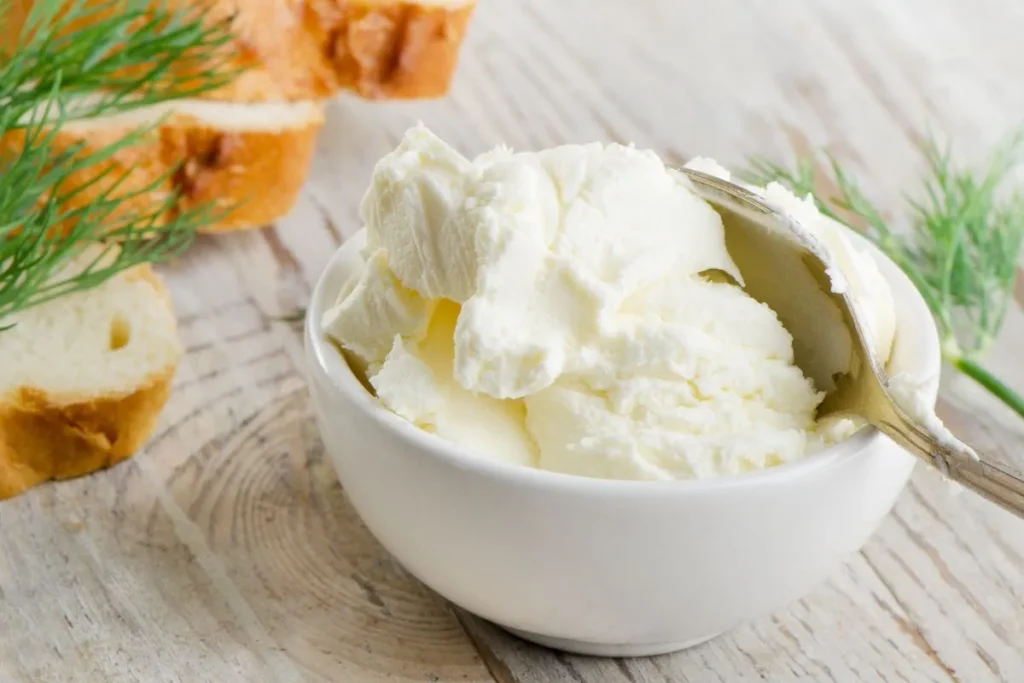Cream cheese is a soft, fresh cheese made from milk and cream, characterized by its smooth, spreadable texture and mild, slightly tangy flavour. First produced in the United States in the late 19th century, it has become a versatile kitchen staple.
Cream cheese is used in a wide range of dishes, from creamy cheesecakes and frostings to savoury dips and spreads. It typically has a high fat content of around 33%, which contributes to its rich consistency.
While rich, it offers small amounts of protein, vitamin A, and B12, though it’s relatively low in calcium compared to aged cheeses.

Top 12 Facts About Cream Cheese:
- Source of Milk: Cow milk
- Texture: Smooth and spreadable
- Colour: White to off-white
- Flavour: Mild, tangy, and creamy
- Fat Content: 33-55%
- Aging Time: Fresh, not aged
- Pasteurized: Usually pasteurized
- Country of Origin: United States
- Town: Produced in various locations
- Named After: The cream content and texture
- Certification: No specific certification
- Uses: Ideal for spreads, baking, and dips
ALSO READ: Camembert Cheese: A Comprehensive Guide
Find out about cream cheese’s nutritional profile and health considerations, including its benefits and dietary impact, on Wikipedia’s nutrition section
In this guide, we will explore, the history of cream cheese, how it is produced, and the uses of cream cheese in different dishes, and types:
History of Cream Cheese
Origins
The history of cream cheese dates back to the late 19th century in the United States. It was first produced by William Lawrence of Chester, New York, in 1872. Lawrence accidentally invented cream cheese while attempting to create a French cheese called Neufchâtel. His innovation led to the creation of a richer, creamier cheese that quickly gained popularity.
Commercialization
In 1880, Lawrence partnered with A.L. Reynolds, a New York cheese distributor, to market the product. They began selling it under the brand name “Philadelphia Cream Cheese,” a nod to the city known for its high-quality dairy products. By the early 20th century, Philadelphia Cream Cheese had become a household name, solidifying its place in American culinary culture.
Global Spread
The popularity of cream cheese spread beyond the United States, becoming a staple in many countries. Its versatility and mild flavour made it a favourite in various cuisines, from European to Asian dishes. Today, cream cheese is enjoyed worldwide in both savoury and sweet applications.
Production of cream cheese
Cream cheese is a beloved dairy product known for its creamy texture and tangy flavor. It’s a versatile ingredient used in everything from bagels to desserts. Here’s a detailed step-by-step guide on how cream cheese is produced, including the ingredients needed.
The ingredients required to make cream cheese:
- Whole Milk: Provides the base and primary source of milk solids.
- Heavy Cream: Adds richness and creaminess to the cheese.
- Starter Culture: Contains lactic acid bacteria for fermentation.
- Rennet: An enzyme that helps coagulate the milk.
- Salt: Enhances flavor and acts as a preservative.
1. Preparing the Milk and Cream
The production of cream cheese starts with a careful selection of high-quality whole milk and heavy cream. The milk and cream are blended together in precise proportions to achieve the desired fat content.
Typically, a mixture of 10-14% milk fat is used. This mixture is then pasteurized by heating it to a high temperature to eliminate any harmful bacteria, ensuring the safety and longevity of the product.
2. Adding Starter Culture
After pasteurization, the milk and cream mixture is cooled to a temperature conducive to bacterial fermentation, usually around 70-75°F (21-24°C). At this stage, a starter culture containing lactic acid bacteria is added.
These bacteria convert lactose (milk sugar) into lactic acid, lowering the pH of the mixture. This acidification process is crucial as it gives cream cheese its distinct tangy flavor and helps in the coagulation process.
3. Coagulation
Once the mixture has been sufficiently acidified, rennet is added. Rennet is an enzyme that causes the milk proteins to coagulate, forming a thick curd.
The mixture is then allowed to sit undisturbed for several hours, typically overnight. During this time, the curds and whey (the liquid part) begin to separate. The longer the mixture sits, the firmer the curd becomes.
4. Draining the Whey
When the curd has reached the desired consistency, the next step is to drain off the whey. This can be done by pouring the mixture into cheesecloth or fine-mesh bags, allowing the whey to drain out naturally.
This process can take several hours. The goal is to remove as much whey as possible to achieve a thick, spreadable consistency.
5. Blending and Smoothing
The drained curds are then transferred to a mixing apparatus where they are blended until smooth. During this step, salt and any additional flavorings are added. Salt not only enhances the flavor but also acts as a preservative.
The blending process is crucial to ensure a uniform, creamy texture. Some manufacturers may also add stabilizers to improve the texture and shelf life.
ALSO READ: Discovering The Cottage Cheese
6. Packaging
The final product, now smooth and creamy, is ready for packaging. It is important to package cream cheese in airtight containers to maintain its freshness and prevent contamination.
Once packaged, the cream cheese is stored at a cool temperature until it is ready to be distributed to stores and eventually to consumers.
Types of Cream Cheese

While the classic version is the most common, there are several types of cream cheese available:
- Regular Cream Cheese: The standard version with a rich, creamy texture.
- Whipped Cream Cheese: Light and airy, achieved by whipping the cheese to incorporate air.
- Flavored Cream Cheese: Includes additional ingredients like herbs, spices, fruits, or vegetables.
- Low-Fat and Non-Fat Cream Cheese: Options for those looking to reduce their fat intake without sacrificing flavor.
Culinary Uses of Cream Cheese

Breakfast and Brunch
Cream cheese shines in breakfast and brunch dishes. It’s creamy texture and mild flavor complement various ingredients.
Bagels and Toast
A classic pairing, cream cheese spread on a toasted bagel or bread is a quick and satisfying breakfast. Add toppings like smoked salmon, avocado, or jam for extra flavour.
Pancakes and Waffles
Cream cheese can be used in batters or as a topping for pancakes and waffles. A dollop of sweetened cream cheese with fresh berries adds a luxurious touch.
Omelets and Scrambles
Incorporate cream cheese into omelets or scrambled eggs for a creamy, rich texture. It pairs well with herbs, vegetables, and smoked salmon.
Appetizers and Snacks
Cream cheese is a versatile ingredient for appetizers and snacks, providing a creamy base for various flavors.
Dips and Spreads
Cream cheese is the foundation for many dips and spreads. Mix it with herbs, spices, or other cheeses for a flavorful dip. Popular recipes include spinach and artichoke dip, buffalo chicken dip, and herbed cheese spread.
Stuffed Vegetables
Use cream cheese to stuff vegetables like bell peppers, mushrooms, or celery sticks. These make for easy and delicious snacks or appetizers.
Pinwheels and Roll-Ups
Spread cream cheese on tortillas or flatbreads, add fillings like deli meats, vegetables, and herbs, then roll up and slice into pinwheels for a tasty snack.
ALSO READ: The Ultimate Guide to Bel Paese Cheese
Main Courses
Cream cheese can elevate main courses by adding richness and creaminess to dishes.
Pasta and Sauces
Cream cheese is a great addition to pasta sauces, providing a creamy texture and tangy flavor. It can be used in Alfredo sauce, carbonara, or baked pasta dishes.
Stuffed Chicken or Fish
Stuff chicken breasts or fish fillets with a mixture of cream cheese, herbs, and vegetables for a flavorful main course.
Casseroles
Incorporate cream cheese into casseroles for added creaminess. It works well in dishes like macaroni and cheese, lasagna, and baked ziti.
Desserts
Cream cheese is a key ingredient in many desserts, adding richness and a tangy flavor.
Cheesecakes
Perhaps the most famous cream cheese dessert, cheesecake is a beloved treat. Cream cheese provides the smooth, creamy texture that makes cheesecake so decadent.
Frosting and Fillings
Cream cheese frosting is a popular choice for cakes, cupcakes, and cookies. Its tangy sweetness pairs well with flavors like carrot, red velvet, and pumpkin.
Pastries and Baked Goods
Cream cheese can be used in a variety of baked goods, from Danish pastries to cream cheese-filled muffins. It adds moisture and flavour to the dough or batter.
Conclusion
Cream cheese’s unique combination of texture, flavour, and versatility makes it a valuable ingredient in any kitchen. Whether you’re looking to create a delicious breakfast, a savoury appetizer, or a decadent dessert, cream cheese can elevate your culinary creations. Understanding what cream cheese is and how to use it effectively opens up a world of delicious possibilities.
ALSO READ: The Ultimate Guide to Danish Blue Cheese
For popular cream cheese recipes and ideas, visit BBC Good Food, which covers a range of cream cheese uses in cooking and baking. Their resources are available at BBC Good Food.
FAQ of cream cheese?
What is cream cheese?
Cream cheese is a soft, spreadable cheese made from milk and cream, known for its mild flavor and creamy texture.
What are the different types of cream cheese?
Common types include regular, reduced-fat, whipped, and flavored varieties, each with unique uses in cooking and baking.
How should cream cheese be stored?
Cream cheese should be kept in the refrigerator, tightly sealed to maintain freshness and prevent drying out.
What dishes can I make with cream cheese?
Cream cheese is versatile and can be used in cheesecakes, frostings, dips, spreads, and savory dishes.
More on Cheese
- Exploring Parmesan or Parmigiano-Reggiano cheese
- Mozzarella cheese | Origins, Production, uses
- The Ultimate Guide to Ricotta Cheese
- Homemade Ricotta Cheese Recipe
- Complete guide to Feta cheese
- Discovering The Cottage Cheese
- The Ultimate Guide to Danish Blue Cheese
- The Ultimate Guide to Bel Paese Cheese
- Camembert Cheese: A Comprehensive Guide
- 27 different types of cheese: their origin and uses
- Service of cheese in restaurants
Subscribe and join our community of hospitality professionals & students — get insights, tips, and the latest updates delivered straight to your inbox!







